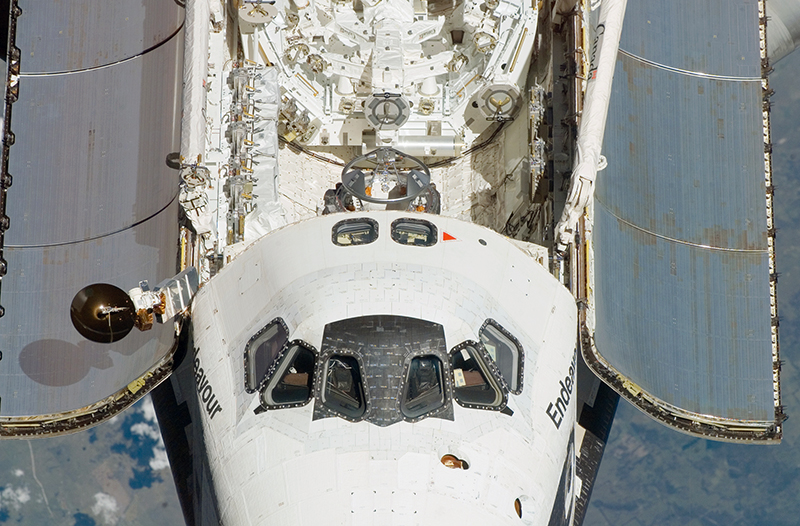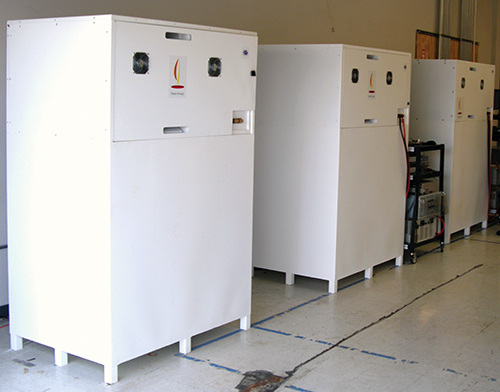
Battery Technology Stores Clean Energy
Originating Technology/NASA Contribution
Affordable and reliable clean energy has been a tantalizing, but elusive, quarry. Featured in Spinoff 1985 and pioneered by Lawrence Thaller at Lewis (now Glenn) Research Center in the 1970s as a potential alternate energy source for long-term space flight, iron-chromium redox energy storage systems are a hybrid technology that offers the extended support of fuel cells with the flexibility of batteries. They act as “electron buckets” for existing clean energy sources, such as solar or wind, to store and deliver power predictably when needed.
In iron-chromium redox systems, electricity is generated when pumps move the electrolytes into separate sections of a reaction chamber. Electrodes collect that charge, and the electrolytes can then be recharged from an outside power source. Thaller’s initial design was a 1-kilowatt system (2 kilowatts at its peak), which used acidified chromium and iron in its solution and relied on soluble redox couples and an ion exchange membrane to generate and store energy in a liquid electrolyte solution.
Partnership
Headquartered in Fremont, California (with offices in Gurgaon, India), Deeya Energy Inc. is now bringing its iron-chromium hybrid flow batteries to commercial customers around the world. Thaller supported Deeya’s founder, Saroj Sahu, providing development assistance for the company’s proprietary liquid-cells (l-cells.) The l-cells have higher power capability (3 kilowatts) than Thaller’s original design, and in January 2008, the Space Foundation approved the l-cells as a Certified Space Technology, a designation for products made possible by space research and development.
Product Outcome
According to Rick Winter, an engineer and vice president with the company, Deeya’s l-cells offer a few fundamental differences from the original redox system. “With the advent of modern plastics, we have been able to replace critical components, dramatically improving the system’s performance, cost, and life,” Winter explains. “We have improved the reliability and reduced the component count and cost so that it can be commercially competitive.” Deeya l-cells are effectively 3 times less expensive than lead-acid batteries and 10 to 20 times less expensive than nickel-metal hydride batteries, lithium-ion batteries, and fuel cell options. The system represents a clean energy technology with no poisonous or expensive metals or fumes release.
Like the original redox system, l-cells offer several advantages over traditional lead-acid batteries: lower cost, longer life, small space needs, and excellent performance at high ambient temperatures. Because l-cells, according to Winter, “actually enjoy sitting in the sun,” rural communities in India with power supply problems have expressed interest in the technology. Deeya has tested the l-cells in air temperatures up to 120 °F, and offer significantly better performance than lead-acid, which only perform reliably in moderately cool temperatures. L-cells also have the ability to operate for thousands of discharge cycles without boost charging, as opposed to the current generation of rechargeable batteries, which are only good for 200 to 500 deep discharge cycles.
Deeya l-cells store energy within the electrolyte itself, with no solid materials, such as lead-oxide, required. This approach completely decouples the power and energy ratings of the systems. As such, system power is defined by the size of the electrode stacks, and available energy depends only on the size of the electrolyte tanks. Due to the low cost of the active materials, the technology lends itself to applications needing extended support times. Deeya l-cells also have no harmful metals or fumes and are completely recyclable, making them a clean replacement for lead-acid batteries and diesel generators. The most impressive difference between Deeya l-cells and lead-acid batteries, however, is the life expectancy. Under standard use, lead-acid batteries tend to need replacement every 18 months, whereas Deeya l-cells need refurbishing only every 7 years after which they can last indefinitely. In heavy use applications, they are expected to provide three times the life of lead-acid batteries.
Deeya is now building the “smallest flow batteries in the industry,” focusing on 2-kilowatt applications. Flow batteries, a form of rechargeable battery in which electrolytes flow through a power cell, are often used in load leveling for clean technologies such as wind and solar power that sometimes have intermittent drops in power. Such systems need backup storage methods to even out the high and low periods of demand and energy generation. “With today’s intense interest in energy independence and renewable energy sources,” Winter says, “we should expect to see many full-scale commercial products changing the energy landscape in the next few years.”
According to Winter, Deeya flow batteries can support a standard cell tower for 4 hours with a unit that is “the size of a large refrigerator.” Deeya’s customers include cell phone providers in India who need smaller backup systems for their cell towers. Because of the backup l-cell battery systems, customers see improved reliability of services, including fewer dropped calls and fewer power outages. Other uses for l-cells could include backup systems for cash machines and traffic lights.
Another large-scale application can be found on King Island, near Australia’s Tasmania, where residents installed similar technology to supplement their wind turbine energy farm; they saw a significant reduction in power outages and fuel costs. Flow batteries reduced the island’s carbon dioxide emissions by 2,000 tons per year.
Deeya plans to install many more systems in rural areas in the developing world to provide for improved communications and significant emissions reductions. Plans include “power-station-in-a-box” products for village electrification, combining solar and wind generation sources. Multimegawatt systems will then be developed for large-scale grid-connected applications, since flow cells can improve the operational efficiency and emissions of coal- and gas-fired power plants.
These customers also appreciate the fact that it is easy to increase capacity—by adding more electrolytes—at a relatively low cost. In the long term, Deeya plans to expand into large 50-megawatt batteries. “The bigger the tank, the longer you can support a load,” Winter explains. Pacific Gas and Electric Company and Southern California Edison are both exploring use of these large electricity storage applications using flow batteries for backup systems to wind turbines.

The size of large refrigerators, Deeya Energy’s l-cells can provide backup power to standard cell towers for 4 hours.

Load-leveling liquid redox systems originated as potential energy storage for long-term space flight.













